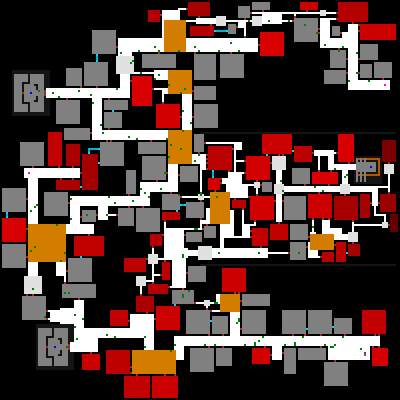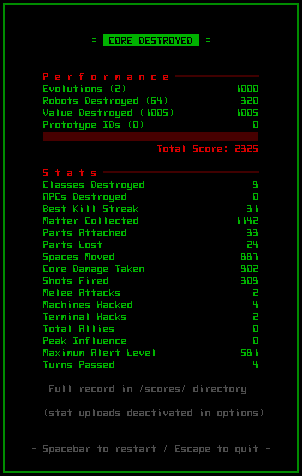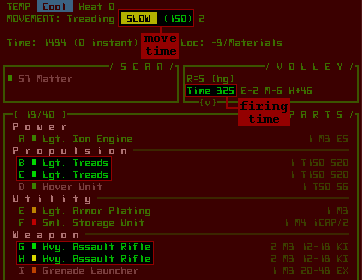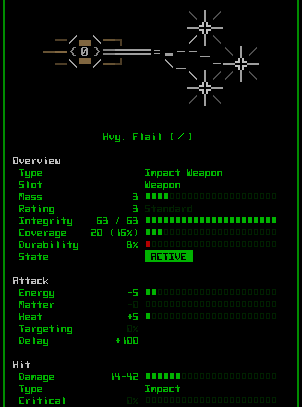Cogmind the Roguelike[Cross-posted from the devblog here--follow link for better formatting and light-on-dark style.]Probably one of the latest hot marketing terms to see rampant use in the indie scene is "roguelike," regardless of whether it really suits the game in question.
No, I don't plan to tackle that can of worms (the topic gets more than enough attention over on
/r/roguelikes), but I would like to begin a series of posts aimed at clarifying "what makes Cogmind a roguelike," and, more importantly, what perhaps unexpected features it adds to the mix.
We'll start with the basics, those features which most players familiar with the genre have come to expect.
Procedural GenerationThis is the element that has apparently become synonymous with "roguelike," which is completely wrong--granted it's an absolutely required core feature of roguelikes, but the genre is defined by so much more than PCG (procedural content generation).
For each new game Cogmind generates the world layout, individual maps, and procedurally* distributes what content you might encounter. *Note that "procedural" is
not "random"--the process is driven by data and algorithms with a purpose.
However, overuse or misuse of PCG risks leading to a bland experience, thus most roguelikes don't go so far as full procedural generation of enemies, items, etc. Neither does Cogmind. Players and the world itself can both benefit from a certain amount of static content to latch onto. In Cogmind we could easily generate robots from an assortment of parts (considering we have so many), but there's a lot of value in keeping robots (and parts) hand-crafted as they are. Static content has two advantages, enabling 1) us to build the game's lore around specific dependable content and 2) players to form a strategy around known factors in an otherwise ever-changing world.
In this area Cogmind is therefore pretty much what you expect from a roguelike: maps are generated, most everything else is defined beforehand and referenced by the generator when putting those maps together. The approach is sufficient to provide infinite replayability without putting too great a burden on the player to relearn
everything with each new play.

Cogmind's map generator building factory map layouts for a 200x200 space from a combination of algorithms and a few hand-made prefab pieces.
Another roguelike staple, permadeath goes hand-in-hand with procedural generation. In case you didn't know, permadeath means no loading saved games aside from continuing your most recent game, and loss is permanent (unless you're
cheating!=p). It would be quite boring if a game forced you to restart from the beginning on failure without offering a new experience each time, hence the advantage of procedural maps here.

You'll be seeing a lot of this until you get the hang of it. (One of the performance indicators is obscured as it's a minor spoiler. Also, the factors that contribute to your final score will likely be changing.)
Cogmind is actually more forgiving than many traditional roguelikes. In most roguelikes if you stand motionless and unresponsive next to an enemy, you'll probably be dead in mere turns.
Not so with Cogmind. While I wouldn't recommend letting enemies wail on you, the mechanics are such that sudden death is
impossible. Even quick death is unlikely unless you're intentionally avoiding the most basic defensive measures (or you're exploring optional dangerous areas in the late-game).
You are pretty resilient and most likely to die from poor planning/decision-making, or attrition (this works because there is
no normal way to heal/repair damage beyond reaching new areas!). The pre-alpha is currently not balanced enough to promise you won't run into some very deadly situations, but the final goal is a fair game in which you can win a majority of runs once you've accumulated enough meta experience.
Despite the long-term attrition approach to success or failure, rarely are you forced into a "walking dead" scenario wherein you're pretty much guaranteed to lose the game but just haven't died yet.
For the experienced player, comebacks are commonplace. You can be reduced to a barely functioning mobile pile of scrap, only to several hundred turns later once again be an armored four-legged menace bristling with cannons (or maybe you decided to keep a low profile and stole some flight units and sensor gear instead).
And even for the new player, there's always the opportunity to simply absorb the damage from attacks while fleeing (or even outrun pursuers) until you happen across an exit, which might be just around the next corner.
In short, there is always hope! On reaching a new area you'll (usually) be safe from attack for a bit, giving you a chance to build up if necessary.
Turn-BasedThis is a somewhat controversial factor of roguelikeness, more so in modern times where there's a high degree of genre mixing going on in the indie segment. Roguelike gameplay traditionally takes place in both discrete time and space (the two are fairly complementary). Certainly all the classic roguelikes fall under this category.
Roguelikes are a test of problem solving skills rather than reflexes, thus we should have as much time as necessary to consider options and make decide on a course of action. Sure we're all guilty of the "pressed the key too many times and died" experience, but we
did have the opportunity to stop and think if we hadn't gotten so complacent at the wrong time!
This puts pausable real-time games like FTL into a gray area I won't address here, but I do think
non-pausable real-time games, while they can certainly embrace the roguelike spirit, really belong to a different category ("roguelites") because they test decision-making from a different angle by putting an emphasis on physical coordination.
Anyway, Cogmind is turn-based and grid-based, the latter part so ingrained in the UI that even the map tileset doesn't use connected wall segments.
Regarding the turn-based mechanics, for those who haven't played the prototype I should briefly introduce how it works. Cogmind uses a "time-energy" system as seen in a number of other roguelikes: Each game turn gives every actor (robot) 100 units of time, and performing an action reduces the available time by the cost (duration) of that action. Whichever robot has the greatest available "time" is the next to act. So performing actions with a greater time requirement will allow other robots to perform more actions before you can act again (unless they, too, perform time-consuming actions).
All of this happens under the hood, though you'll get a feel for it as you play, plus some of the numbers are shown to you where important to help make comparisons and weigh decisions.
Most actions take about 100 time units, i.e. can be carried out once per turn. There are primarily two other actions that can vary greatly in how much time they require: movement and shooting.

Current speed in "time to move one space" as shown in the HUD. Also the amount of time required to fire the currently active volley of weapons.
One significant difference between Cogmind's design and the average "time-energy" system (or other similar system) is that in other games the time differences between actions are intentionally fairly subtle, or at least don't exceed a certain reasonable threshold. By comparison it's possible in Cogmind to have extremely exaggerated time costs, so be careful of that! This would be a result of your own design, something you have to aim to balance while maintaining peak efficiency for the functionality you want.
In a worst case scenario assuming you're a massive hulk of parts hopping along on one leg, you could move a single space and suddenly everyone within sight gets 2-3 shots at you, and again for every further step you take (in this case, if your goal is to escape, you may be forced to drop your stuff and run; or pull out that grenade launcher you've been hoarding and make a stand!).
The opposite is also true: you could fly so fast that enemies don't even
see you as you zip down the corridor and off into another room.
As you can see your speed value is incredibly important to how things play out.
Firing weapons can have a similarly exaggerated effect on relative time since you're allowed to fire as many weapons as you want, but the total firing time could span multiple turns during which other robots can continue to act.
This makes large attacks front-loaded (since you are in effect spending a block of future time that you don't have--time energy can be negative), but dangerous if used improperly. The benefit to larger volleys is that each additional weapon requires less additional time to fire, until it's almost insignificant (because the more firing, the more that are able to do so simultaneously).
There is a lot of tactical decision-making involved in how many of what type of weapon to fire at what kind of target, but that will be for you to explore.
CombatAh, bumping into something until you kill it, the time-honored simplest method of conflict resolution in roguelikes.
It's true that roguelikes don't
have to be combat-oriented, but aside from fun 7DRL experiments we see that that the most popular roguelikes are all about causing death and destruction.
For all its guns, cannons, and missile launchers, Cogmind is actually kind of an anti-combat game. Unlike in other roguelikes, combat is
not a way to improve yourself. Sure you can "re-appropriate" parts scrapped from a robot, but there are also plenty found elsewhere for the taking (and what you find elsewhere is
better, no less).
This has the advantage of making the stealth approach a much more meaningful strategy, which the game has
plenty of
mechanics to support. You aren't required to fight anything at all. That said, it's likely that even the stealthiest Cogmind, and most players aiming to win (as opposed to just causing mayhem, which is lots of fun, too), will end up fighting the occasional battle in the interest of avoiding greater confrontations that are even more difficult to evade or control. (For example, if you encounter a lone patrol squad that might spot you and warn others, you have the choice to lure them to a suitable battleground and take them out, or take a detour and risk it.)
Most roguelikes are heavy on combat, and while the genre is now trending towards more interesting forms of interaction than bump-them-til-they-die, melee attacks remain a staple action. They take a back seat in Cogmind.
In fact, Cogmind's original prototype had no melee weapons at all--they have since been
added as a new option you probably won't solely rely on, but that do come in handy in certain situations.

Handy indeed...
The vast majority of the combat in Cogmind takes place at range, which changes the experience significantly. This is not you one-sidedly mowing down waves of short-range attackers approaching from a distance; encounters are all-out firefights in which almost every enemy you meet can pound you from range.
Not only that, but you can fire as many weapons as you can attach and power at once, none of those left hand, right hand limits


About to let loose (poor strategy--one grenade or rocket at a time would be enough for these guys). I made this into a gif so you could see the scene in both ASCII and tiles.
Interaction is a key gameplay element in roguelikes. While items (and usually by extension an inventory) are by no means required for a roguelike, they do offer a useful medium for expanding the number of possible interactions.
I've already covered Cogmind's unique inventory system and its impact on gameplay in great detail in a
separate post.
 Community
Community DevLogs
DevLogs Cogmind (sci-fi robot-themed roguelike) - BETA RELEASED
Cogmind (sci-fi robot-themed roguelike) - BETA RELEASED Community
Community DevLogs
DevLogs Cogmind (sci-fi robot-themed roguelike) - BETA RELEASED
Cogmind (sci-fi robot-themed roguelike) - BETA RELEASED
